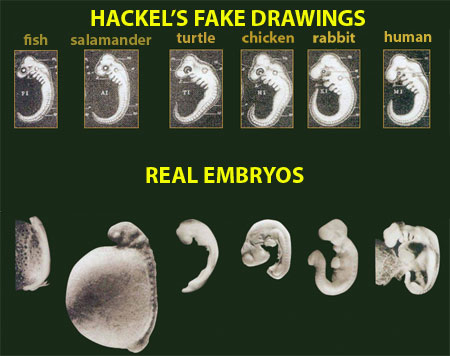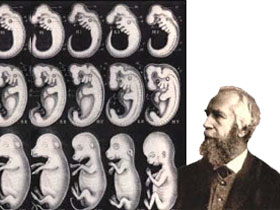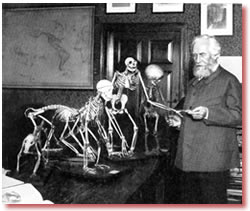|
|
But the true state of affairs was very different. Haeckel had produced a drawing of just a single embryo, and then produced human, monkey and dog embryos from this by making very small changes. In other words, it was a hoax.
That was the supposed “scientific work” (!) that Darwin citied as a reference in his book The Descent of Man. In fact, some people realized that Haeckel’s illustrations were a distortion even before Darwin wrote his book. Following the exposure of the fraud, Haeckel himself admitted the huge scientific fraud he had perpetrated:
After this compromising confession of 'forgery' I should be obliged to consider myself condemned and annihilated if I had not the consolation of seeing side by side with me in the prisoner's dock hundreds of fellow - culprits, among them many of the most trusted observers and most esteemed biologists. The great majority of all the diagrams in the best biological textbooks, treatises and journals would incur in the same degree the charge of 'forgery,' for all of them are inexact, and are more or less doctored, schematised and constructed.[i]
But in order to keep the dogma of Darwinism propped up, there was a need to declare that one of the false pieces of evidence in their possession was actually “proof of evolution.” The fraud perpetrated or Darwinists being aware of it was unimportant; what mattered in Darwinists’ eyes was for it to be heralded as evidence of evolution, even if it was fraudulent.
Despite the exposure of the fraud, Darwin and the biologists who supported him continued to regard Haeckel’s drawings as a reference source. And that further encouraged Haeckel. In the years that followed he produced further series of comparative embryo illustrations. He prepared diagrams showing fish, salamander, turtle, chicken, rabbit and human embryos side by side. The noteworthy aspect of these was how the embryos of these different life forms initially resembled one another very closely and gradually diverged over the course of their development. The similarity between the human and fish embryos in particular was very striking indeed. So much so that fictitious “gills” could be seen in the human embryo drawings, just as in those of the fish. Under the scientific guise he gave these illustrations, Haeckel launched his “theory of recapitulation:” Ontology Repeats Phylogeny. The meaning of the slogan was this; according to Haeckel, during the developmental process it undergoes in the egg or the mother’s womb, every living thing repeats the “evolutionary history” of its species, right from the very beginning. For example, the human embryo in the mother’s womb first resembles a fish and then, in subsequent weeks, a salamander, a reptile and a mammal, finally “evolving” into a human being.

But this was a huge fraud.
In the 1990s the British embryologist Michael Richardson examined vertebrate embryos under the microscope and determined no resemblance to Haeckel’s drawings. Following their study, Richardson and his team published genuine photographs of embryos in the August 1997 issue of the journal Anatomy and Embryology. It appeared that Haeckel had taken various template designs and distorted them in various ways so that the embryos would resemble one another. He added imaginary organs to embryos, removed organs from others and depicted embryos of very different sizes as being the same in scale. The clefts that Haeckel depicted as “gills” in the human embryo had in fact nothing to do with gills at all. They were actually the middle ear canal and the beginnings of the parathyroid and thymus glands. The embryos did not in fact resemble one another at all. Haeckel had made all kinds of distortions in his illustrations.
An article about Haeckel’s drawings, for long maintained on the agenda as false evidence of evolution, appeared in the September 5, 1997, issue of Science magazine titled “Haeckel’s Embryos: Fraud Rediscovered,” following which the whole scientific world agreed that there had been a fraud. The article contained the following lines:
Not only did Haeckel add or omit features, Richardson and his colleagues report, but he also fudged the scale to exaggerate similarities among species, even when there were 10-fold differences in size. Haeckel further blurred differences by neglecting to name the species in most cases, as if one representative was accurate for an entire group of animals. In reality, Richardson and his colleagues note, even closely related embryos such as those of fish vary quite a bit in their appearance and developmental pathway. "It (Haeckel's drawings) looks like it's turning out to be one of the most famous fakes in biology,"[ii]
In March 2000 the Harvard University evolutionist and paleontologist Stephen Jay Gould said that he had long been aware of this fraud. But he had preferred to remain silent, as required by the system of the Dajjal.[iii] Once the public had learned that the drawings were fraudulent, Gould stated that it was academic murder for them still to be used and said: "We do, I think, have the right, to be both astonished and ashamed by the century of mindless recycling that has led to the persistence of these drawings in a large number, if not a majority, of modern textbooks."[iv]
Haeckel’s fraud was so blatant and so great that he was accused of fraud by five different professors and found guilty by the Jena University court.[v]
Sir Gavin de Beer, from Great Britain’s Natural History Museum, described this terrible disgrace as follows:
Seldom has an assertion like that of Haeckel’s ‘theory of recapitulation,’ facile, tidy, and plausible, widely accepted without critical examination, done so much harm to science.”[vi]
These false illustrations of Haeckel’s in fact achieved their intended aim on behalf of evolution. Although they had been declared to be false, they still had a negative impact as a great many people still imagined them to be genuine, and despite their scientific invalidity they still negatively altered the general views regarding human beings and themselves of people still undergoing education in schools. Henry M. Morris, founder of the Creation Research Society and the Institute of Creation Research analyzed the state of affairs in these terms:
Ever since Darwin—and especially since Freud—psychologists have assumed that man is merely an evolved animal and have evaluated his behaivoral problems on an animalistic basis. Experiments with monkeys or other animals (even with insects) are used for guidance in dealing with human problems...The bitter fruit of the recapitulation theory (long since discredited scientifically) continued to grow in many areas of society...[vii]
Amazingly enough, Haeckel’s fraudulent illustrations, described as a scientific disgrace and treated with amazement even by some evolutionists when put forward as evidence, still maintain their place in various text books. This astonishing state of affairs shows the exact scale of the Darwinist deception. The University of California molecular biologist Jonathan Wells describes the situation thus:
Many textbooks use slightly redrawn versions of Haeckel’s embryos. One example is the 1999 edition of Peter Raven and George Johnson’s Biology, which accompanies its drawings with the following caption: “Notice that the early embryonic stages of these vertebrates bear a striking resemblance to each other.” The text also informs students: “Some of the strongest anatomical evidence supporting evolution comes from comparisons of how organisms develop. In many cases, the evolutionary history of an organism can be seen to unfold during its development, with the embryo exhibiting characteristics of the embryos of its ancestors.”
Other examples include the 1998 edition of Cecie Starr and Ralph Taggart’s Biology: the Unity and Diversity of Life, which accompanies its drawings with the mis-statement that “the early embryos of vertebrates strongly resemble one another;” the latest edition of James Gould and William Keeton’s Biological Science, which reports: “One fact of embryology that pushed Darwin toward the idea of evolution is that the early embryos of most vertebrates closely resemble one another;” and Burton Guttman’s 1999 textbook, Biology, which accompanies its redrawn version of Haeckel’s embryos with the following: “An animal’s embryonic development holds clues to the forms of its ancestors.”[viii]
The fact that Haeckel’s false illustrations are still used in biology text books, as if they represented proof of evolution, is without doubt no simple error. Although being forgeries, these illustrations are deliberately included in text books. The main reason for this is without doubt that they represent significant false evidence for the key point of Darwinism, the falsehood that man is an irresponsible animal. Jonathan Wells makes this comment about this lie deliberately maintained by Darwinist scientists:
Haeckel’s embryos seem to provide such powerful evidence for Darwin’s theory that some version of them can be found in almost every modern textbook dealing with evolution. Yet biologists have known for over a century that Haeckel faked his drawings; vertebrate embryos never look as similar as he made them out to be. Furthermore, the stage Haeckel labeled the “first” is actually midway through development; the similarities he exaggerated are preceded by striking differences in earlier stages of development. Although you might never know it from reading biology textbooks, Darwin’s “strongest single class of facts” is a classic example of how evidence can be twisted to fit a theory.[ix]
Although Darwinists were delighted in the short term that a lie planned by the dajjal was put forward as false evidence for a heretical theory and had such an impact, it in fact heralded terrible disappointment for them. Through Haeckel's drawings, people saw the scale of the deception to which a senior scientist would go in the name of Darwinism. It was thus once again proved how Darwinism was in constant need of a “lie.” People clearly saw how evolutionists could turn a blind eye to fraud. Haeckel's fraud was another significant piece of evidence of the destruction of the theory of evolution and the system of the dajjal. This fraud may have been met with silence in the 20th century, but the 21st century has seen this and similar frauds exposed and the genuine scientific evidence put on display. The more frauds have been exposed and the more genuine scientific evidence produced, the more the collapse of Darwinism has become ever more apparent.
[i] Francis Hitching, The Neck of the Giraffe: Where Darwin Went Wrong, New York: Ticknor and Fields 1982, p. 204
[ii] Science, 5 September 1997, Elizabeth Pennisi
[iii] Ann Coulter, Godless The Church of Liberalism, Crown Forum Publishing, 2006, p. 240
[iv] http://www.arn.org/docs/richards/jr_sciedreport.htm
[v] Hank Hanegraaff, Fatal Flaws "What Evolutionists Don't Want You To Know", W Publishing Group, 2003, p. 70
[vi] Hank Hanegraaff, Fatal Flaws "What Evolutionists Don't Want You To Know", W Publishing Group, 2003, p. 70
[vii] Henry M. Morris, The Long War Against God, Master Books, 2000, p. 32
[viii] Jonathan Wells, Icons of Evolution, Regnery Publishing, Inc., p. 103
[ix] Jonathan Wells, Icons of Evolution, Regnery Publishing, Inc., pp. 82, 83



